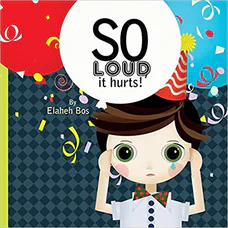So Loud It Hurts!
Written and illustrated by Elaheh Bos
36 pages
•
Published 2015 (CreateSpace Independent Publishing Platform)

Recommended Age Range: Any child who is able to express themselves verbally–perhaps preschool through 2nd or 3rd grade, but it could be appropriate for older children who are struggling to express themselves and their sensory needs.
Publisher's Summary:
Gus loves almost everything about his birthday. But when the sounds become too loud, he feels overwhelmed and needs to remember what silence feels like. This book is a starting point to help children who suffer from sound sensitivity relate and take control of what is happening to them.

Dr. Annie's Takeaways
Recommended for: This book encourages children to problem solve and self-advocate in order to reduce their exposure to sensations that are uncomfortable to them (in this case, loud noises at a birthday party). It’s a perfect fit for any child who has dreaded a birthday party due to a fear that popping balloons or a loud rendition of the Happy Birthday song will overwhelm them. It is not specific to autism-related sensory sensitivities but would be a good fit for an autistic child with sensitivity to sounds.
Would a child like it? It’s not the most engaging story, but for kids who are dreading a noisy event, this book is validating and empowering.
Evidence-Based Practices:
Effective Communication
Tone: Validating, hopeful
Story Quality: This is a simple story about a boy’s birthday party, and it isn’t particularly artful. However, it is clear and direct, with no metaphors or allusions that might confuse children or go over their heads. The result is a book that feels respectful to its child audience.
Illustrations: Colorful digital illustrations featuring people with big, exaggerated eyes.
Representation: Gus is a White boy with White family members. He has a father, mother, little sister, grandmother, grandfather, and aunt. His friends have different genders and ethnicities. Gus is very sensitive to loud sounds, including clapping, his dog barking, balloons popping, high-pitched voices, and the Happy Birthday song. There are no labels used in the story to describe Gus.
Psychological Practices: This story promotes self-advocacy related to sensory sensitivity, and it helps children to make a plan to cope with loud noises. Gus loves many things about his birthday (e.g., baking rainbow cake with his grandmother, playing with his friends, watching the candles flicker on the cake), but he does not like all of the noises that often accompany birthday parties–his dog barking, balloons popping, people singing Happy Birthday. These loud noises “mak[e] his heart jump and his ears hurt.” After a particularly noisy Happy Birthday song, Gus snaps at everyone (“Stop making noise!”) and runs to his room and cries. The party guests are surprised but compassionate, and his father joins him in his room to help. Gus’s father helps Gus to realize the party guests didn’t mean to make Gus uncomfortable, and there are some things that can’t be helped (like his aunt’s high-pitched voice), but there are many things he could ask for that would help him feel more comfortable. They come up with a plan: Gus asks the guests to whisper Happy Birthday rather than sing it loudly, the dog goes outside so he won’t bark at people, and the balloons are moved to Gus’s sister’s room so they wouldn’t pop. The plan works, and the story ends on a hopeful note: “There was good food, good fun and good company. It was a very quiet birthday, and Gus loved it.” The back of the book includes resources to help a child make their own plan to manage sounds, including relaxation and coping strategies.
Concerns: Accommodating sensory sensitivities (e.g., by asking guests to whisper the Happy Birthday song) is best accompanied by some exposure and desensitization work in order to increase a child’s ability to tolerate sensations. However, an event like a birthday party can be far too challenging without a plan like Gus’s, and some accommodation is totally okay here. If a child is able to self-advocate and have some control over their exposure to feared or uncomfortable sensory experiences, it can be very empowering.
